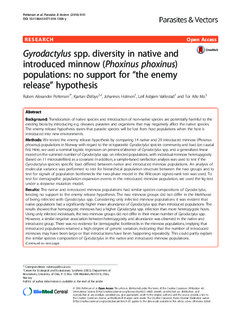Gyrodactylus spp. diversity in native and introduced minnow (Phoxinus phoxinus) populations: no support for “the enemy release” hypothesis
Pettersen, Ruben Alexander; Østbye, Kjartan; Holmen, Johannes; Vøllestad, Leif Asbjørn; Mo, Tor Atle
Journal article, Peer reviewed
Permanent lenke
http://hdl.handle.net/11250/2393886Utgivelsesdato
2016Metadata
Vis full innførselSamlinger
Originalversjon
Pettersen, R. A., Østbye, K., Holmen, J., Vøllestad, L. A., & Mo, T. A. (2016). Gyrodactylus spp. diversity in native and introduced minnow (Phoxinus phoxinus) populations: no support for "the enemy release" hypothesis. Parasites & Vectors, 9(51). doi:10.1186/s13071-016-1306-y 10.1186/s13071-016-1306-ySammendrag
Background: Translocation of native species and introduction of non-native species are potentially harmful to the
existing biota by introducing e.g. diseases, parasites and organisms that may negatively affect the native species.
The enemy release hypothesis states that parasite species will be lost from host populations when the host is
introduced into new environments.
Methods: We tested the enemy release hypothesis by comparing 14 native and 29 introduced minnow (Phoxinus
phoxinus) populations in Norway with regard to the ectoparasitic Gyrodactylus species community and load (on caudal
fin). Here, we used a nominal logistic regression on presence/absence of Gyrodactylus spp. and a generalized linear
model on the summed number of Gyrodactylus spp. on infected populations, with individual minnow heterozygosity
(based on 11 microsatellites) as a covariate. In addition, a sample-based rarefaction analysis was used to test if the
Gyrodactylus-species specific load differed between native and introduced minnow populations. An analysis of
molecular variance was performed to test for hierarchical population structure between the two groups and to
test for signals of population bottlenecks the two-phase model in the Wilcoxon signed-rank test was used. To
test for demographic population expansion events in the introduced minnow population, we used the kg-test
under a stepwise mutation model.
Results: The native and introduced minnow populations had similar species compositions of Gyrodactylus,
lending no support to the enemy release hypothesis. The two minnow groups did not differ in the likelihood
of being infected with Gyrodactylus spp. Considering only infected minnow populations it was evident that
native populations had a significantly higher mean abundance of Gyrodactylus spp. than introduced populations. The
results showed that homozygotic minnows had a higher Gyrodactylus spp. infection than more heterozygotic hosts.
Using only infected individuals, the two minnow groups did not differ in their mean number of Gyrodactylus spp.
However, a similar negative association between heterozygosity and abundance was observed in the native and
introduced group. There was no evidence for demographic bottlenecks in the minnow populations, implying that
introduced populations retained a high degree of genetic variation, indicating that the number of introduced
minnows may have been large or that introductions have been happening repeatedly. This could partly explain
the similar species composition of Gyrodactylus in the native and introduced minnow populations.
